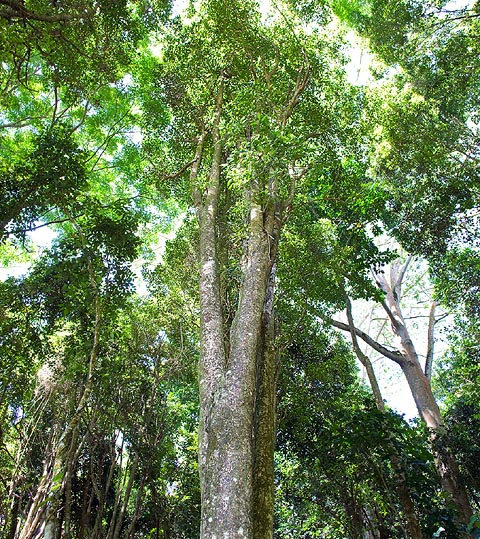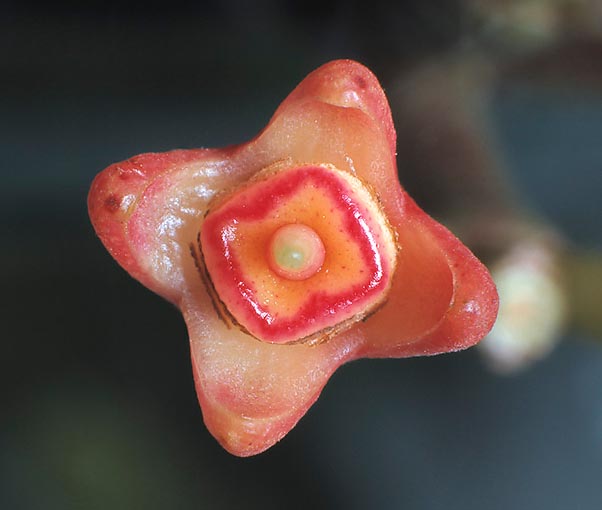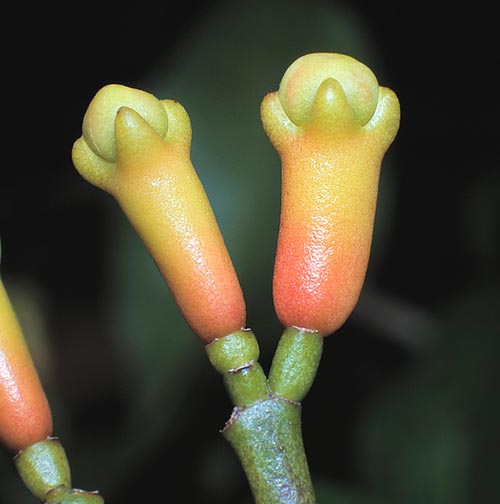Family : Myrtaceae

Text © Pietro Puccio

English translation by Mario Beltramini

The Syzygium aromaticum may be more than 20 m tall © Giuseppe Mazza
The name of the genus is the combination of the Greek terms “sys” = together, and “zygon” = yoke, with reference to the petals, which in some species are merged.
The name of the spcies is the Latin term “aromaticum” = aromatic, with obvious reference.
Common names: clove, cloves, clovetree, nail of clove (English); qaranful (Arabic); clous de girofle, giroflier (French); lavang (Hindi); cengkeh, cingkeh (Indonesian); chiodo di garofano (Italian); craveiro da India, cravo-aromático, cravo-da-India, cravo-das-Molucas, cravo-de-cabecinha, cravo-de-doce (Portuguese); árbol del clavo, clavero giroflé, clavo de olor (Spanish); karafuu (Swahili); Gewürznelkenbaum (German).
The Syzygium aromaticum Merr. & L.M.Perry (1939) is an erect evergreen tree, with numerous ascending branches, of initially conical shape, up to about 20 m tall, even if it keeps lower when cultivated, with grey and smooth bark.
The leaves are opposite, from oblong to elliptic with sharp apex, 6-16 cm long and 3-6 cm broad, coriaceous, of pink colour in the young leaves, then glossy dark green, aromatic due to the presence of several oleiferous glands in the lower page.
The inflorescences are terminal panicles, about 5 cm long, carrying up to 20 hermaphrodite flowers, with an intense perfume, usually in groups of 3-4, with 4 triangular sepals, initially of yellowish green colour, then, gradually, red when the flowers opens; 4 roundish petals of reddish colour, of about 6 mm of length, which fall down after the opening, and numerous 7 mm long, white, stamina. The fruit is an ovoid berry of dark red or purple colour, 2,5 cm long, containing only one oblong, about 1,5 cm long, seed.

Flower close-up. The fruits are harvested in bud for producing the spice © Giuseppe Mazza
The germination takes place in 2-6 weeks and the first blooming happens between the fifth and the ninth year of age.
It is a species suitable for purely humid tropical climate, with abundant rainfall distributed almost uniformly all over the year, and high temperatures as it gets already serious damages if the same drop below the 10 °C.
It is to be cultivated in full sun, but when young, when it needs shade, and sheltered from the wind, on soils rich of organic substance, also clayey, provided well draining.
The tree supplies on of the most ancient and prized spices, the cloves, which have a penetrating odour and aromatic and pungent taste, utilized for aromatizing dishes of meat and rice, but also sweets and drinks, and amply employed in the traditional medicine.
In the eastern countries, particularly in China and Japan, they are also utilized as incense, and, in Indonesia, most of the local production is added, pulverized, to the tobacco in the cigarettes called “kretek”.

Hand-picked, they darken while drying and get the look of a nail © Giuseppe Mazza
The oil has anti-oxidant, antibacterial and fungicide properties and till the recent past it was utilized in the mouth and throat inflammations and as local anaesthetic in dentistry; the pure oil is, however, to be utilized with great caution, under supervision of medical staff, being greatly irritant.
The Syzygium aromaticum is cultivated in Indonesia, which is the greatest producer, Madagascar, Réunion, Sri Lanka and Tanzania (in particular, Zanzibar and Pemba).
Synonyms: Caryophyllus aromaticus L. (1753); Eugenia caryophyllata Thunb. (1788); Caryophyllus hortensis Noronha (1790); Myrtus caryophyllus Spreng. (1825); Caryophyllus silvestris Teijsm. ex Hassk. (1866); Eugenia aromatica (L.) Baill. (1876); Jambosa caryophyllus (Thunb.) Nied. (1893); Eugenia caryophyllus (Spreng.) Bullock & S.G.Harrison (1958).
→ To appreciate the biodiversity within MYRTACEAE family please click here.
